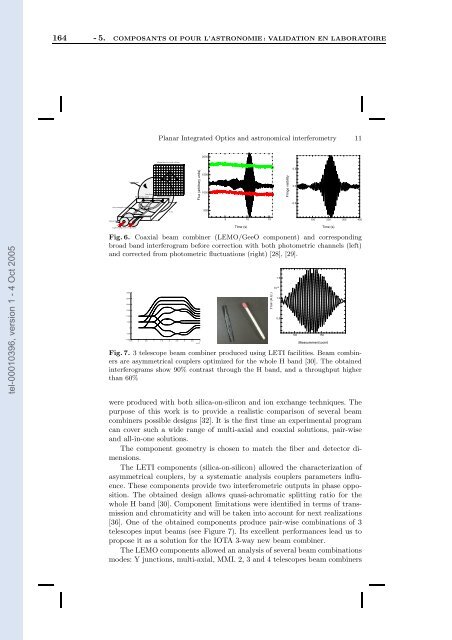Qualification de IONIC, instrument de recombinaison ...
Qualification de IONIC, instrument de recombinaison ...
Qualification de IONIC, instrument de recombinaison ...
Create successful ePaper yourself
Turn your PDF publications into a flip-book with our unique Google optimized e-Paper software.
tel-00010396, version 1 - 4 Oct 2005<br />
164 - 5. COMPOSANTS OI POUR L’ASTRONOMIE : VALIDATION EN LABORATOIRE<br />
Ion exchanged wavegui<strong>de</strong>s<br />
Optical fiber<br />
Imaging lens<br />
Light coming from two apertures<br />
250 µm<br />
250 µ m<br />
Glass substrate<br />
250 µm<br />
Planar Integrated Optics and astronomical interferometry 11<br />
Infrared <strong>de</strong>tector insi<strong>de</strong> a <strong>de</strong>war<br />
Image of the 3 outputs<br />
Interferometric output<br />
Photometric output Photometric output<br />
Yjunctions<br />
2 cm<br />
Flux (arbitrary units)<br />
. . . . . . . . . .<br />
.<br />
.<br />
. . . . .<br />
. . .<br />
.<br />
.<br />
.<br />
.<br />
.<br />
.<br />
.<br />
.<br />
.<br />
.<br />
. .<br />
. ..<br />
. . .<br />
.<br />
.<br />
. .<br />
.<br />
. . .<br />
. .<br />
.<br />
.<br />
.<br />
.<br />
. .<br />
. .<br />
. . .<br />
.<br />
. . . .<br />
.<br />
.<br />
. .<br />
.<br />
.<br />
. .<br />
. . .<br />
. . .<br />
.<br />
.<br />
. .<br />
.<br />
.<br />
.<br />
.<br />
. .<br />
.<br />
.<br />
.<br />
. .<br />
.<br />
. .<br />
.<br />
.<br />
. .<br />
.<br />
.<br />
B B BB B B B B B B<br />
B B B BB B<br />
B BBB B BB B B<br />
B<br />
B B B<br />
B B BB B B C C<br />
B<br />
C C CC C C C C C C C C C<br />
C<br />
C CCC C<br />
C CC C C C CCC CCC CC<br />
C C 2000<br />
C<br />
1500<br />
1000<br />
500<br />
.<br />
5 10 15<br />
Time (s)<br />
.<br />
. .<br />
0.5<br />
.<br />
.<br />
. .<br />
.<br />
0.0 .<br />
. .<br />
.<br />
. . .<br />
.<br />
.. . .<br />
.<br />
.<br />
.<br />
. . . . .<br />
. .<br />
. .<br />
.<br />
. .<br />
.<br />
.<br />
.<br />
.<br />
.<br />
.<br />
. .<br />
.<br />
.<br />
. .<br />
. .<br />
.<br />
. . .<br />
. . .<br />
-0.5<br />
.<br />
.<br />
.<br />
.<br />
. .<br />
.<br />
Fringe visibility<br />
.<br />
.<br />
100 200 300 400<br />
Fig. 6. Coaxial beam combiner (LEMO/GeeO component) and corresponding<br />
broad band interferogram before correction with both photometric channels (left)<br />
and corrected from photometric fluctuations (right) [28], [29].<br />
3000<br />
2500<br />
2000<br />
1500<br />
1000<br />
500<br />
0<br />
−500<br />
−0.5 0 0.5 1 1.5 2 2.5 3 3.5 4<br />
x 10 4<br />
−1000<br />
Flux (A.U.)<br />
1.5<br />
10 +4<br />
1.0<br />
0.5<br />
100 150<br />
Measurement point<br />
Fig. 7. 3 telescope beam combiner produced using LETI facilities. Beam combiners<br />
are asymmetrical couplers optimized for the whole H band [30]. The obtained<br />
interferograms show 90% contrast through the H band, and a throughput higher<br />
than 60%<br />
were produced with both silica-on-silicon and ion exchange techniques. The<br />
purpose of this work is to provi<strong>de</strong> a realistic comparison of several beam<br />
combiners possible <strong>de</strong>signs [32]. It is the first time an experimental program<br />
can cover such a wi<strong>de</strong> range of multi-axial and coaxial solutions, pair-wise<br />
and all-in-one solutions.<br />
The component geometry is chosen to match the fiber and <strong>de</strong>tector dimensions.<br />
The LETI components (silica-on-silicon) allowed the characterization of<br />
asymmetrical couplers, by a systematic analysis couplers parameters influence.<br />
These components provi<strong>de</strong> two interferometric outputs in phase opposition.<br />
The obtained <strong>de</strong>sign allows quasi-achromatic splitting ratio for the<br />
whole H band [30]. Component limitations were i<strong>de</strong>ntified in terms of transmission<br />
and chromaticity and will be taken into account for next realizations<br />
[36]. One of the obtained components produce pair-wise combinations of 3<br />
telescopes input beams (see Figure 7). Its excellent performances lead us to<br />
propose it as a solution for the IOTA 3-way new beam combiner.<br />
The LEMO components allowed an analysis of several beam combinations<br />
mo<strong>de</strong>s: Y junctions, multi-axial, MMI. 2, 3 and 4 telescopes beam combiners<br />
Time (s)

















